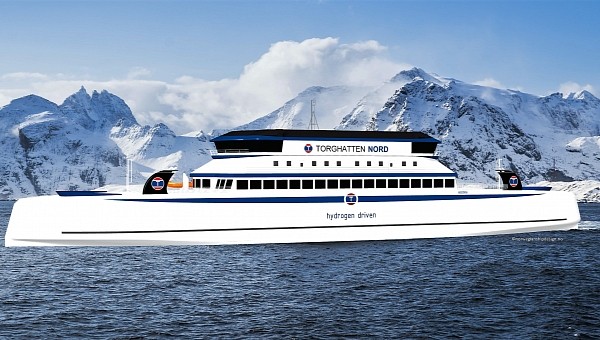Battery-electric ferries are already “old news,” it’s time for hydrogen-powered alternatives to take the lead. Norway, who was already one of the main promotors of LNG (liquefied natural gas) in the maritime industry, is determined to play a major role in the emerging green hydrogen sector, starting with a project that claims to be the largest one of its kind in the world.
With around 800 ferry lines, it’s no wonder that Norway is looking at ferries as a priority for implementing green propulsion solutions.
The longest ferry connection in the state is Vestfjord. This is a large basin situated between the Norwegian mainland and the Lofoten islands, covering around 100 miles (160 km) in length and 50 miles (80 km) in width. The government has decided that all ferries for the Vestfjord connections should be emission-free.
And, because these are demanding routes that can take up to four hours to complete, the new vessels also require an extensive range. This is why green hydrogen was selected as the best solution.
Torghatten Nord, a domestic transport group, will be operating the two new hydrogen-powered ferries. It might not seem so at first glance, but this is a massive project, valued at nearly €20 million ($21.3 million). In fact, it claims to be the largest hydrogen project for the maritime industry, in the world.
We’re also talking about very large vessels. A single one of these ferries will have the capacity to carry 599 passengers, 120 cars, and 12 trucks. Considering this, in addition to the long routes they will cover, the future Torghatten Nord ferries require a powerful propulsion system.
Two companies are in charge of this. SEAM, a technology company specializing in zero-emission alternatives for the maritime industry, will provide the entire powertrain, plus the control and safety systems. But the fuel cells for the powertrain will be supplied by PowerCell, which has recently joined forces officially with SEAM.
PowerCell has contributed to hydrogen-based aviation projects as well. The company’s fuel cell solution for vessels is called the Marine System 200, and will ensure a total output of 13 MW for future ferries. However, it seems that the ferries won’t rely 100% on hydrogen. According to SEAM, the government requirements are asking for a minimum of 85% hydrogen. At the same time, the rest can be covered by biofuel, which also helps cut emissions.
Overall, these two vessels alone are expected to eliminate up to 30,000 tons of CO2 per year (the CO2 emission equivalent of 13,000 diesel cars).
The only bad news is that such a large-scale project takes time. There are still two more years to go until the new ferries will start regular operations in the Vestfjord, running mostly on hydrogen.
The longest ferry connection in the state is Vestfjord. This is a large basin situated between the Norwegian mainland and the Lofoten islands, covering around 100 miles (160 km) in length and 50 miles (80 km) in width. The government has decided that all ferries for the Vestfjord connections should be emission-free.
And, because these are demanding routes that can take up to four hours to complete, the new vessels also require an extensive range. This is why green hydrogen was selected as the best solution.
Torghatten Nord, a domestic transport group, will be operating the two new hydrogen-powered ferries. It might not seem so at first glance, but this is a massive project, valued at nearly €20 million ($21.3 million). In fact, it claims to be the largest hydrogen project for the maritime industry, in the world.
We’re also talking about very large vessels. A single one of these ferries will have the capacity to carry 599 passengers, 120 cars, and 12 trucks. Considering this, in addition to the long routes they will cover, the future Torghatten Nord ferries require a powerful propulsion system.
Two companies are in charge of this. SEAM, a technology company specializing in zero-emission alternatives for the maritime industry, will provide the entire powertrain, plus the control and safety systems. But the fuel cells for the powertrain will be supplied by PowerCell, which has recently joined forces officially with SEAM.
PowerCell has contributed to hydrogen-based aviation projects as well. The company’s fuel cell solution for vessels is called the Marine System 200, and will ensure a total output of 13 MW for future ferries. However, it seems that the ferries won’t rely 100% on hydrogen. According to SEAM, the government requirements are asking for a minimum of 85% hydrogen. At the same time, the rest can be covered by biofuel, which also helps cut emissions.
Overall, these two vessels alone are expected to eliminate up to 30,000 tons of CO2 per year (the CO2 emission equivalent of 13,000 diesel cars).
The only bad news is that such a large-scale project takes time. There are still two more years to go until the new ferries will start regular operations in the Vestfjord, running mostly on hydrogen.






